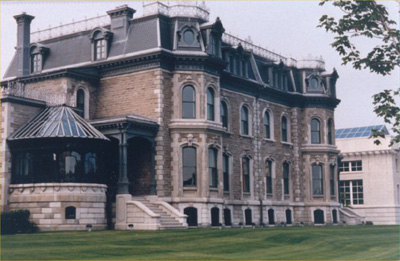Van Horne / Shaughnessy House National Historic Site of Canada
Montréal, Quebec

¾ view of house showing decorative wall features
© Parks Canada Agency / Agence Parcs Canada, 2000
Address :
1923 René-Lévesque Boulevard West, Montréal, Quebec
Recognition Statute:
Historic Sites and Monuments Act (R.S.C., 1985, c. H-4)
Designation Date:
1973-11-15
Dates:
-
1874 to 1875
(Construction)
-
1985 to 1985
(Significant)
Event, Person, Organization:
-
Duncan McIntyre
(Person)
-
Sir William Van Horne
(Person)
-
T.G. Shaughnessy
(Person)
-
Canadian Pacific Railway
(Organization)
-
William T. Thomas
(Architect)
-
Peter Rose
(Architect)
Other Name(s):
-
Van Horne / Shaughnessy House
(Designation Name)
-
Canadian Centre for Architecture
(Other Name)
-
Shaughnessy House
(Other Name)
Plaque(s)
Existing plaque: 1923 René-Lévesque Boulevard West, Montréal, Quebec
Designed by W.T. Thomas and built in 1874, these twin residences recall the period when this street was lined with large mansions with landscaped grounds. The mansard roofs and two storey bay windows, together with contrasting textures of stone work, provide a fine example of the fusion of a contemporary architectural expression, the Second Empire style, with the Montréal greystone tradition. The west house was built for Duncan McIntyre; the east was occupied by William Van Horne and later T.G. Shaughnessy, all of whom were officials of the Canadian Pacific Railway during its completion and consolidation.
Description of Historic Place
The Van Horne / Shaughnessy House National Historic Site of Canada is located in downtown Montréal, Quebec. This symmetrical composition consists of two semi-detached houses finished in the Second Empire style, later merged into one large mansion. Featuring end pavilions, bays and cast iron detailing cresting at the roofline, this elegant building is now surrounded on three sides by buildings and gardens of the Canadian Centre for Architecture. Official recognition refers to the legal property boundary of the Van Horne / Shaughnessy House at the time of designation.
Heritage Value
The Van Horne / Shaughnessy House was designated a national historic site of Canada in 1973 because: these semi-detached houses are a very good example of the fusion between the architectural expression of the time, the Second Empire style, and the Montreal greystone tradition; these semi-detached houses were occupied by senior representatives of the Canadian Pacific Railway, notably William Van Horne, during the construction and consolidation of the first transcontinental railroad line.
Designed and built by William T. Thomas in 1874, Van Horne / Shaughnessy House commemorates a time when Boulevard René-Lévesque (then Dorchester Street) was lined with large opulent houses surrounded by landscaped gardens. The mansard roof, two-storey bay windows, symmetrical façades and stone textured walls speak to the architectural influences of the time, the Second Empire style, and the Montreal greystone tradition. The west house was originally built for Duncan McIntyre while the east house was first occupied by William Van Horne and later T.G. Shaughnessy, all of whom were associated with the construction and consolidation of the Canadian Pacific Railway.
Over the years, several changes affecting the interiors have been made. The historic building, once threatened with demolition in the 1980s, was rehabilitated and integrated into the new building of the Canadian Centre for Architecture following the drawings of architect Peter Rose. The Van Horne / Shaughnessy House now serves as reception rooms and offices for the Canadian Centre for Architecture museum.
Source: Historic Sites and Monuments Board of Canada, Minutes, Novembre 1985.
Character-Defining Elements
Key elements that contribute to the heritage character of the site include: its location in downtown Montréal, Quebec; its setting, set back from the street and facing the St. Lawrence River; its three-storey Second Empire style rectangular pavilion essentially symmetrical, reflecting the design of semi-detached houses; its rough-faced stone construction with ashlar trim; its ornate mansard roof with iron cresting pierced with tripartite dormer windows; the balanced placement of the doors and the windows; its south façade with its generally segmental openings shape windows on the first floor and semi-circular openings shape windows on the second floor; its two-storey bay windows located symmetrically at each end of the south façade topped with semi-circular openings shape windows and ornate round-arched windows at the roofline; the diversity of the windows, including the use of palladian and elliptical windows in the slope of the mansard roof; its extremely ornate stone cornice and frieze on the eaves together with the decorative woodwork on the window dormers, windows and porches; its conservatory; the surviving original interior decoration and finishes; the integrity of any surviving evidence of the original interior layout.